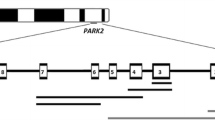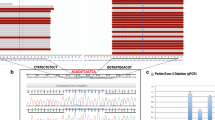Abstract
Genomic rearrangements (exon dosage) are common mutations reported in Parkinson's disease (PD) patients. In the present study, we aimed to investigate the prevalence of genomic rearrangements in 88 South African patients with predominantly early-onset PD (age-at-onset ≤50 years). The multiplex ligation-dependent probe amplification method was used to detect exon dosage changes. Two commercially available probe kits, SALSA P051 and P052, were used and together the kits consisted of probes for exons of α-synuclein, parkin, PINK1, DJ-1, LRRK2, UCH-L1, ATP13A2, LPA, TNFRSF9, CAV2, CAV1, GCH1, and two-point mutations. We identified exonic rearrangements in parkin and α-synuclein in 8% of South African patients from different ethnic groups. One patient had a whole-gene triplication of α-synuclein; representing only the fourth family with this mutation reported to date. We found six patients with parkin mutations who had either heterozygous duplications and deletions, or homozygous deletions. A false positive result of an exonic deletion detected in one patient turned out to be homozygous point mutation (Y258X) in PINK1. No exonic rearrangements were found in four of the PD genes; LRRK2, PINK1, DJ-1, and ATP13A2. Mutations in parkin were the predominant genetic cause; however, the frequency of exon dosage in our study group is low compared with previous studies. This indicates the possible involvement of other as yet unidentified PD genes in the development of the disease in the South African population.



Similar content being viewed by others
References
Lesage S, Brice A (2009) Parkinson's disease: from monogenic forms to genetic susceptibility factors. Hum Mol Genet 18(R1):R48–R59
Alves G, Forsaa EB, Pedersen KF, Dreetz Gjerstad M, Larsen JP (2008) Epidemiology of Parkinson's disease. J Neurol 255(Suppl 5):18–32
Hedrich K, Kann M, Lanthaler AJ, Dalski A, Eskelson C, Landt O et al (2001) The importance of gene dosage studies: mutational analysis of the parkin gene in early-onset parkinsonism. Hum Mol Genet 10(16):1649–1656
Hedrich K, Marder K, Harris J, Kann M, Lynch T, Meija-Santana H et al (2002) Evaluation of 50 probands with early-onset Parkinson's disease for Parkin mutations. Neurology 58(8):1239–1246
Kitada T, Asakawa S, Hattori N, Matsumine H, Yamamura Y, Minoshima S et al (1998) Mutations in the parkin gene cause autosomal recessive juvenile parkinsonism. Nature 392(6676):605–608
Periquet M, Latouche M, Lohmann E, Rawal N, De Michele G, Ricard S (2003) French Parkinson's Disease Genetics Study Group; European Consortium on Genetic Susceptibility in Parkinson's Disease. Parkin mutations are frequent in patients with isolated early-onset parkinsonism. Brain 126(Pt 6):1271–1278
Shadrina MI, Semenova EV, Slominsky PA, Bagyeva GH, Illarioshkin SN, Ivanova-Smolenskaia II, Limborska SA (2007) Effective quantitative real-time polymerase chain reaction analysis of the parkin gene (PARK2) exon 1–12 dosage. BMC Med Genet 26(8):6
Sun M, Latourelle JC, Wooten GF, Lew MF, Klein C, Shill HA et al (2006) Influence of heterozygosity for parkin mutation on onset age in familial Parkinson disease: the GenePD study. Arch Neurol 63(6):826–832
Chartier-Harlin MC, Kachergus J, Roumier C, Mouroux V, Douay X, Lincoln S et al (2004) Alpha-synuclein locus duplication as a cause of familial Parkinson's disease. Lancet 364(9440):1167–1169
Ibáñez P, Bonnet AM, Débarges B, Lohmann E, Tison F, Pollak P et al (2004) Causal relation between alpha-synuclein gene duplication and familial Parkinson's disease. Lancet 364(9440):1169–1171
Ross OA, Braithwaite AT, Skipper LM, Kachergus J, Hulihan MM, Middleton FA et al (2008) Genomic investigation of alpha-synuclein multiplication and parkinsonism. Ann Neurol 63(6):743–750
Singleton AB, Farrer M, Johnson J, Singleton A, Hague S, Kachergus J et al (2003) Alpha-synuclein locus triplication causes Parkinson's disease. Science 302(5646):841
Marongiu R, Brancati F, Antonini A, Ialongo T, Ceccarini C, Scarciolla O et al (2007) Whole gene deletion and splicing mutations expand the PINK1 genotypic spectrum. Hum Mutat 28(1):98
Djarmati A, Hedrich K, Svetel M, Schäfer N, Juric V, Vukosavic S et al (2004) Detection of Parkin (PARK2) and DJ1 (PARK7) mutations in early-onset Parkinson disease: Parkin mutation frequency depends on ethnic origin of patients. Hum Mutat 23(5):525
Djarmati A, Guzvić M, Grünewald A, Lang AE, Pramstaller PP, Simon DK et al (2007) Rapid and reliable detection of exon rearrangements in various movement disorders genes by multiplex ligation-dependent probe amplification. Mov Disord 22(12):1708–1714
Scarciolla O, Brancati F, Valente EM, Ferraris A, De Angelis MV, Valbonesi S et al (2007) Multiplex ligation-dependent probe amplification assay for simultaneous detection of Parkinson's disease gene rearrangements. Mov Disord 22(15):2274–2278
Gibb WRG, Lees AJ (1988) A comparison of clinical and pathological features of young-onset and old-onset Parkinson's disease. Neurology 38(9):1402–1406
Bardien S, Keyser RJ, Yako Y, Lombard D, Carr J (2009) Molecular analysis of the parkin gene in South African patients diagnosed with Parkinson's disease. Parkinsonism Relat Disord 15(2):116–121
Hedrich K, Eskelson C, Wilmot B, Marder K, Harris J, Garrels J et al (2004) Distribution, type, and origin of Parkin mutations: review and case studies. Mov Disord 19(10):1146–1157
Ballabio A, Bardoni B, Guioli S, Basler E, Camerino G (1990) Two families of low-copy-number repeats are interspersed on Xp22.3: implications for the high frequency of deletions in this region. Genomics 8(2):263–270
Chen KS, Manian P, Koeuth T, Potocki L, Zhao Q, Chinault AC, Lee CC, Lupski JR (1997) Homologous recombination of a flanking repeat gene cluster is a mechanism for a common contiguous gene deletion syndrome. Nat Genet 17(2):154–163
Yen PH, Li XM, Tsai SP, Johnson C, Mohandas T, Shapiro LJ (1990) Frequent deletions of the human X chromosome distal short arm result from recombination between low copy repetitive elements. Cell 61(4):603–610
Lee JA, Lupski JR et al (2006) Genomic rearrangements and gene copy-number alterations as a cause of nervous system disorders. Neuron 52(1):103–121
Hattori N, Kitada T, Matsumine H, Asakawa S, Yamamura Y, Yoshino H et al (1998) Molecular genetic analysis of a novel Parkin gene in Japanese families with autosomal recessive juvenile parkinsonism: evidence for variable homozygous deletions in the Parkin gene in affected individuals. Ann Neurol 44(6):935–941
Klein C, Lohmann-Hedrich K, Rogaeva E, Schlossmacher MG, Lang AE (2007) Deciphering the role of heterozygous mutations in genes associated with parkinsonism. Lancet Neurol 6(7):652–662
Brüggemann N, Mitterer M, Lanthaler AJ, Djarmati A, Hagenah J, Wiegers K et al (2009) Frequency of heterozygous Parkin mutations in healthy subjects: need for careful prospective follow-up examination of mutation carriers. Parkinsonism Relat Disord 15(6):425–429
Farrer M, Kachergus J, Forno L, Lincoln S, Wang DS, Hulihan M (2004) Comparison of kindreds with parkinsonism and alpha-synuclein genomic multiplications. Ann Neurol 55(2):174–179
Ibáñez P, Lesage S, Janin S, Lohmann E, Durif F, Destée A et al (2009) Alpha-synuclein gene rearrangements in dominantly inherited parkinsonism: frequency, phenotype, and mechanisms. Arch Neurol 66(1):102–108
Abeliovich A, Schmitz Y, Fariñas I, Choi-Lundberg D, Ho WH, Castillo PE et al (2000) Mice lacking alpha-synuclein display functional deficits in the nigrostriatal dopamine system. Neuron 25(1):239–252
Yavich L, Tanila H, Vepsäläinen S, Jäkälä P (2004) Role of alpha-synuclein in presynaptic dopamine recruitment. J Neurosci 24(49):11165–11170
Tan EK, Yew K, Chua E, Puvan K, Shen H, Lee E et al (2006) PINK1 mutations in sporadic early-onset Parkinson's disease. Mov Disord 21(6):789–793
Gandhi S, Muqit MM, Stanyer L, Healy DG, Abou-Sleiman PM, Hargreaves I et al (2006) PINK1 protein in normal human brain and Parkinson's disease. Brain 129(Pt7):1720–1731
Clark IE, Dodson MW, Jiang C, Cao JH, Huh JR, Seol JH et al (2006) Drosophila pink1 is required for mitochondrial function and interacts genetically with parkin. Nature 441(7097):1162–1166
Park J, Lee SB, Lee S, Kim Y, Song S, Kim S et al (2006) Mitochondrial dysfunction in Drosophila PINK1 mutants is complemented by parkin. Nature 441(7097):1157–1161
Petit A, Kawarai T, Paitel E, Sanjo N, Maj M, Scheid M et al (2005) Wild-type PINK1 prevents basal and induced neuronal apoptosis, a protective effect abrogated by Parkinson disease-related mutations. J Biol Chem 280(40):34025–34032
Valente EM, Abou-Sleiman PM, Caputo V, Muqit MM, Harvey K, Gispert S et al (2004) Hereditary early-onset Parkinson's disease caused by mutations in PINK1. Science 304(5674):1158–1160
Bonifati V, Rohé CF, Breedveld GJ, Fabrizio E, De Mari M, Tassorelli C et al (2005) Early-onset parkinsonism associated with PINK1 mutations: frequency, genotypes, and phenotypes. Neurology 65(1):87–95
Klein C, Djarmati A, Hedrich K, Schäfer N, Scaglione C, Marchese R et al (2005) PINK1, Parkin, and DJ-1 mutations in Italian patients with early-onset parkinsonism. Eur J Hum Genet 13(9):1086–1093
Rogaeva E, Johnson J, Lang AE, Gulick C, Gwinn-Hardy K, Kawarai T et al (2004) Analysis of the PINK1 gene in a large cohort of cases with Parkinson disease. Arch Neurol 61(12):1898–1904
Ephraty L, Porat O, Israeli D, Cohen OS, Tunkel O, Yael S, Hatano Y et al (2007) Neuropsychiatric and cognitive features in autosomal-recessive early parkinsonism due to PINK1 mutations. Mov Disord 15;22(4):566–569
Acknowledgments
We thank the study participants. Ms. Lindsey Adams is thanked for providing technical advice. This work was supported by the South African Medical Research Council, the Harry and Doris Crossley Foundation, and the University of Stellenbosch, South Africa.
Conflicts of interest
None declared.
Author information
Authors and Affiliations
Corresponding author
Rights and permissions
About this article
Cite this article
Keyser, R.J., Lombard, D., Veikondis, R. et al. Analysis of exon dosage using MLPA in South African Parkinson's disease patients. Neurogenetics 11, 305–312 (2010). https://doi.org/10.1007/s10048-009-0229-6
Received:
Accepted:
Published:
Issue Date:
DOI: https://doi.org/10.1007/s10048-009-0229-6




